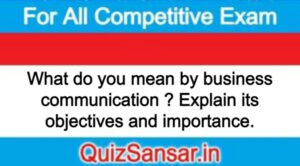
What do you mean by business communication ? Explain its objectives and importance.
What do you mean by business communication ? Explain its objectives and importance.
Or
“Communication means the process of passing information and understanding from one person to another.” Discuss the statement.
Or
“Management is like a two way traffic, it is based upon effective machinery of communication.” Comment.
Or
“Communication is the sum of all things one person does when he wants to create understanding in the mind of another. It is a bridge of words. It involves a systematic and continuous process of telling, listening and understanding.” Discuss in detail.
Or
“The single most significant characteristic of the human race is the ability to communicate.” Elaborate.
Or
What do you mean by Communication in Management? Explain the characteristics of a good communication.
Ans.
Meaning of Communication
Communication is one of the most important aspect of life. Seventy percent of our active hours are spent in communication. The word ‘communication’ originated from the Latin word “Communis” denoting “common”. Thus, we can say that the term communication has been derived from the Latin word “communis” which means commonness. Communication can be defined as the process through which two or more persons come to exchange idea. Communication is an exchange of written or verbal information. Communication is the process of passing information and ideas from one person to another.
Infact communication means convey a message by one person to another so that another person may understand, follow and implement the message.
“Communication is an exchange of facts, ideas, opinion or emotions by two or more persons.”
If one person is unable to follow the message of another, it cannot be called as communication. For example, if the chairman of an enterprise delivers his speech in English in the annual general meeting and there is no person who can understand English, it cannot be called communication.
It is the process of passing information and views from one person to another. Communication is the exchange of written or verbal ideas. Communication means convey a message by one person to another so that another person may understand, follow and implement the message.
In the present time communication has become very wide and easy due to recent scientific change. In existing era telephone, radio, satellite, telegraph, television, e-mail etc. are commonly used.
Communication is started by birth of a human being. The form of communication has changed with the development of civilization. It arised due to unlimited needs of human being. In the ancient period leaves were used for communication. Communication is used by every being but human uses it specifically and impressively. It is an art and one who is expert in this art is very impressive and successful.
Communication’s role is very vital for a business concern. Communication informs to the business organization. Under the process of communication facts, views, ideas and attitudes are exchanged and goals can be achieved easily by collective efforts.
Communication is an effective weapon in the hands of management of business concern. It helps in completing the work of the corporate world. Communication plays highly significant contribution in the development of business and industry. In the present time development of business is not possible without communication. In the present time corporate communication is significant like blood circulation in human body. A well communication system can make rapid business progress of the corporate sector. In the present dynamic business environment communication is essential. In the corporate communication concern or its members communicate their views, emotions, reactions, data etc. Communication procedure generate internal as well as external relationship of industry, commerce and trade.
Definitions of Communication
The term ‘Communication’ has been defined by many eminent scholars as under:
According to Louis A. Allen “Communication is the sum total of all the things that a person does when he wants to create an understanding in the mind of another. It involves a systematic and continuous process of telling, listening and understanding.”
Very simple definition has been provided by W.H. Newman and C.F. Summer Jr: “Communication is an exchange of facts, ideas, opinions, or emotions by two or more persons.”
According to Theo Haimann, “Communication means the process of passing information and understanding from one person to another.”
According to Koontz and O’ Donnell, “Communication is an intercourse by words, letters, symbols or messages, and is a way that one organisation member shares meaning and understanding with another.”
According to William Scott, “Administrative communication is a process which involves the transmission and accurate replication of ideas ensured by feedback for the purpose of eliciting actions which will accomplish organisational goals.”
In the words of John Adair “Communication is essentially the ability of one person to make contact with another and to make himself or herself understood. Or, if you prefer a slightly more formal version, communication is the process by which meanings are exchanged between people through the use of a common set of symbols.”
On the basis of above definitions it can be concluded that communication is a process through which two or more persons exchange facts, ideas, opinions or emotions. Communication is a continuous process of telling, listening as well as understanding. In its process two or more persons must share through a medium that carries the information or message for a certain purpose mutually understood by both parties i.e. communicator (sender) and communicatee (receiver)
According to American Management Association, “Any behaviour that results in an exchange of meaning is communication.”
Essential Elements of Business Communication
These are as under:
1. Message: Message or information is the key of communication. There must be a message. It may be in writing or verbal. It may be in the form of information, request or order.
2. Communicator or Sender: There must be a sender of information. Sender or transmitter is a person who wishes of passing on some message.
3. Communicatee or Receiver: There must be a receiver of information. There is another person to whom the message is to be passed on.
4. Understanding of Message: If the communicatee has not understood, the communicator has not communicated.
5. Feedback: Feedback is essential for message. The receiver responds to the message. i.e. feedback. Every communication leads to some reactions or feedback.
Nature of Communication
Nature of communication can be discussed as under;
1. Pervasive Function: Communication is necessary in the areas of business like:
(i) Direction;
(ii) Planning;
(iii) Selection, training, and appraisal;
(iv) Information about tasks, responsibility and authority; and
(v) Controlling.
Communication is vital to all managerial business functions. It is essential to all business areas. It is universal element.
2. Continuous Process: Business organisation cannot exist without communication. Its stop means an end of business activities.
3. Two-way Process: Communication is the sum of all things. One person does when he wants to create understanding in the mind of another. It is a bridge of meaning. It involves a systematic and continuous process of telling, listening and understanding. According to G.R. Terry, “Simply talking or writing without regard to the recipient’s response is conducive to misunderstanding.” Communication is not complete unless the receiver understands the message. Two-way communication, made possible by feedback, has a back-and-forth pattern. In communication, the sender sends the message and the receiver’s response comes back to the sender. Two-way communication is more accurate because the feedback allows the sender to refine his communication, Receiver’s self-confidence is higher in two-way communication. Two way communication may create problems of polarization and cognitive dissonance.
4. Mutual Understanding: The most immediate need for communication is to be able to refer to a core of basic things in the real world, that is, to be able to name things, states, events, attributes, using the words he or she.
5. Conventional and Traditional Bound: According to S.V. Guptan of Administrative Staff College of India, Hyderabad “The different levels of relationship mesh into a matrix communication relationship deeply influenced by the past” Guptan goes on to say. “The past cannot be wished away, however strong the desire. The acous of the past have a definite strong influence, and the long shadows they cast on the lives of present generations, have a clear story to tell.”
6. All Communication is Structured: Every part of communication analyse into the pattern of its message-structuring and come up with useful inference for the use of the business world. For example-
7. Conversational : All communication is by nature conversation.
Macro’ and ‘Micro’ two levels of the structure of communication.






